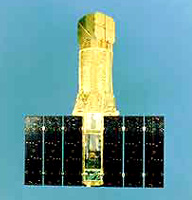TOP > Topics > 2001 > About the descent of ASCA
![]()
About the descent of ASCA
The Japanese X-ray astronomy satellite ASCA was launched from Kagoshima Space Center on February 20, 1993. Since then, it has smoothly been performing observations for about 8 years. However, as a result of recent solar activity, its orbit altitude has been gradually decreased faster than anticipated, and it re-entered the atmosphere on March 2, 2001. At about 14:20 JST, the satellite disappeared at longitude163 deg. East, latitude 8 deg. South over the ocean sky. ASCA kept sending epoch-making observation data right up to the end. The final data was sent on March 1, the day before it descended. It burnt up just as trying to follow Professor Oda, the originator of Japanese X-ray astronomy who had passed away on March 1.

In fact, ASCA stopped its observation since July 15, 2000, due to attitude disturbance originated from a huge solar flare on July 14, and power deficiency during the emergency operation after that. From this incident, it is more accurate to say that ASCA performed scientific observations for 7 years and 3 months since test observations began after the launch in April 1993.
In this period, ASCA logged numerous world-beating X-ray astronomy results. The achievements cover many fields; from nearby star formation areas, the super nova remnants, compact X-ray binary stars, the Galactic center, the more distant galaxies, active galactic nuclei, clusters of galaxies, X-ray background radiation, etc.
Along with the German ROSAT satellite, ASCA has made a real impact on the development of X-ray astronomy in the 1990s. The end of its mission also became the force to drive X-ray astronomy in the new century, such as the Chandra satellite and the XMM Newton satellite.
July 3, 2001




